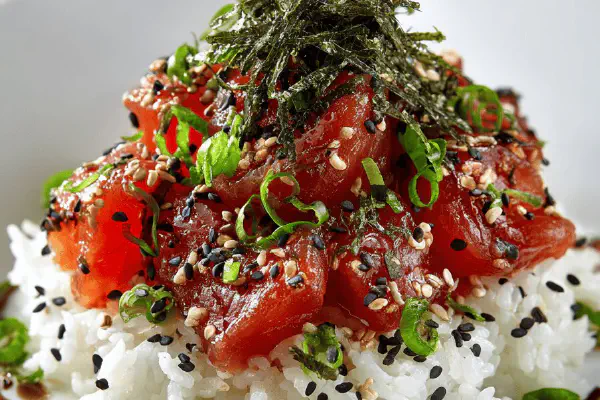Sushi Rice Fish Bowl

By Emma
Certified Culinary Professional
Ingredients
Rice
- 570 ml (2 ⅓ cups) sushi rice
- 500 ml (2 cups) water
- 55 ml (3 ¾ tbsp) white rice vinegar
- 12 ml (2 ½ tsp) mirin
- 20 ml (1 ⅓ tbsp) honey
- 2,5 ml (½ tsp) salt
Marinated Fish
- 65 ml (¼ cup plus 1 tsp) soy sauce
- 35 ml (2 ⅓ tbsp) mirin
- 6 ml (1 ¼ tsp) prepared wasabi
- 430 g (15 oz) sashimi-grade salmon or tuna, thinly sliced
- 12 ml (2 ½ tsp) toasted sesame seeds
- 4 green onions, finely sliced
- 65 ml (¼ cup plus 1 tsp) pickled ginger
- 1 sheet nori, shredded into fine julienne strips
- Extra wasabi paste
About the ingredients
Method
Rice Preparation
- Rinse rice under cold running water in a bowl. Swirl gently, then drain. Repeat rinsing 4–5 times until water runs almost clear but still slightly milky — signals surface starch. Drain rice thoroughly in a fine mesh strainer for at least 10 minutes. Moisture affects cooking consistency.
- Transfer rice and measured water to a medium pot. Stir once, bring to a rolling boil over medium-high. A hinge sound settles; bubbles should form rapidly but not scorch. Immediately reduce heat to lowest setting, cover tightly right away. Simmer 14–16 minutes. Avoid lifting the lid; steam’s job here.
- Turn off heat, keep covered, let rest 12 minutes. Steam finish vital to absorb moisture evenly. Rice should be tender yet grains separate. Overcooked means mush; undercooked feels chalky.
- While rice cooks, combine vinegar, mirin, honey, and salt in a small saucepan over low heat. Warm gently until honey dissolves and mixture slightly thickens, about 3 minutes. Don’t boil; acidity can diminish.
- Transfer cooked rice to large wooden or glass bowl. Pour seasoned vinegar gently over steaming rice. Fold rice carefully using a wooden spatula or rice paddle with slicing motion — not stirring or smashing. Cool by fanning to give sheen and perfect sticky texture. This step is where perfect texture emerges.
- Cover bowl with plastic wrap until rice reaches room temperature. Avoid refrigeration; cold rice kills texture and gloss.
Fish Marinade and Assembly
- Mix soy sauce, mirin, and wasabi paste in a medium bowl until uniform. Adjust wasabi to your heat tolerance; best to start mild, can add at plating.
- Add thin slices of fish. Toss lightly, coating without mashing. Marinate no more than 10 minutes at room temp; too long will change fish texture and color.
- Divide rice among 4 bowls in loose mounds. Lay marinated fish slices overlapping generously over rice. Look for translucent gloss — if dull, fish might be losing freshness.
- Sprinkle evenly with toasted sesame seeds, sliced green onions, shredded nori, and spoon pickled ginger alongside or atop.
- Offer extra wasabi and soy sauce on side. Mix flavors at will.
Tips and Troubleshooting
- Rice too sticky? Could be rinsing insufficient, or overcooked. Next batch rinse more thoroughly. Under sticky? Maybe not steamed long enough.
- No sushi rice? Use short-grain rice but add 1 tbsp more vinegar in seasoning. Other grains won’t work.
- No mirin? Dry sherry or sweet marsala can substitute, but adjust honey amount as sweetness will vary.
- Fish freshness vital. Buy from trusted fishmonger labeled sashimi grade and keep chilled to last minute.
- If no wasabi paste, horseradish mixed with a drop of soy replicates heat.
- Ginger can be swapped for thin pickled daikon or fresh grated ginger but flavor shifts sharply.
- Nori adds umami crunch but can be omitted. Toasted crushed seaweed flakes or furikake can fill in.
- Fanning rice while mixing vinegar cools it and dries surface slightly. Use a handheld fan or piece of cardboard.
- Serving cold rice kills taste and texture; serve at room temp to keep balance.
- Try a tiny sprinkle of furikake or thin cucumber slices for fresh crunch — adds a twist without overpowering.
Final Note
- Master the rice and fish prep, and it’s a breeze. I’ve burned rice once by rushing the simmer; a loss of texture you feel immediately. Dull fish or bad rice ruins it faster than anything else. Smell sharpness from vinegar, sweet honey balance, and toasted sesame aroma pulling together. That’s when you know you nailed it.
Cooking tips
Chef's notes
- 💡 Rinse rice repeatedly until water’s almost clear but faintly cloudy; overdo it and grains dry out, underdo it no glossy sticky surface. Drain thoroughly, moisture ruins steaming consistency. Resting rice post-cook is crucial; steam redistributes, you want grains distinct not mush.
- 💡 Heat vinegar-honey mixture gently enough to dissolve honey fully without boiling; boiling kills acidity, flavor drops. Folding vinegar into hot rice requires slicing motion, no smashing, no stirring. Use wooden paddle for texture; fan rice while folding to cool and dry surface lightly — sheen forms.
- 💡 Marinate fish no more than 10 minutes or it breaks down, dulls. Thin slices critical to prevent bruising during tossing. Start light on wasabi marinade, adjust later at plating; heat changes fish perception. Room temp marinating avoids early spoilage but don’t exceed time or texture suffers.
- 💡 Simmer rice on lowest heat once boiling with lid tight. A rolling boil before that gives hinge sound and rapid bubbles without scorching. Avoid boiling hard during simmer or grains rupture; steam is cooking agent here, not direct water. Cover instantly to seal steam in.
- 💡 Pickled ginger on side works best to cut fatty fish richness. Nori shredded very fine, not chunked harshly — chew texture delicate with contrasting sesame crunch. Toast sesame fresh to wake oils, aroma. Multiple garnishes create layers of mouthfeel and flavor contrast without muddling.
Common questions
How to tell rice is done cooking?
Listen for bubble pattern, rapid but gentle. No loud boil. After simmer time, turn off heat but keep lid closed. Rice rest redistributes steam evenly. Texture should be tender but grains separate when folded. Mush means overcooked, chalky undercooked.
Can I substitute mirin?
Yes, dry sherry plus pinch sugar works. Honey amount might adjust for sweetness. Flavor dims slightly but still okay. Dry marsala can replace too. Never skip sweet element or fish marinade taste goes flat.
What if rice too sticky or too dry?
Sticky usually rinse short, water excess, or overcook. Try more thorough rinsing next time, longer drain. Under sticky means not steamed enough or vinegar mix off. Avoid refrigeration on rice; cold kills texture, turns mushy.
How should leftovers be stored?
Store fish and rice separately if possible. Rice cools to room temp, cover tight but no fridge long-term or texture suffers. Fish best eaten same day chilled well. Reheat rice gently by steaming, avoid microwaving dry. Wasabi and condiments fresh add fresh punch at serving.



